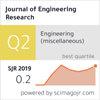考虑尺寸效应的混凝土抗压强度概率分布模型比较研究
IF 2.2
4区 工程技术
Q3 ENGINEERING, MULTIDISCIPLINARY
引用次数: 0
摘要
本文采用正态分布、对数正态分布和威布尔分布三种常见的概率模型,对360个实测强度值进行了混凝土抗压强度概率分布的大小依赖性对比研究。这些强度数据集来自于对240个不同圆柱形尺寸(d×l= 50 ×100 mm、75 ×150 mm、100 ×200 mm和150 ×300 mm)的模制圆柱体和120个不同尺寸(d×l= 50 ×100 mm和75 ×150 mm)的混凝土芯进行的综合压缩试验,这些混凝土芯采用两种不同的混凝土配合比制备。分析表明:(1)无论混凝土试件的配合比、尺寸和类型如何,正态分布不仅为解释混凝土抗压强度的概率分布提供了最相关的模型,而且也为解释其尺寸依赖性提供了最相关的模型,这一点得到了最大对数似然准则和最小距离准则的证实;(ii)混凝土抗压强度的尺寸依赖性导致其概率分布也受试件尺寸的影响;(iii)混凝土抗压强度概率分布的大小依赖关系可以通过正态分布和对数正态分布来解释,但不能通过威布尔分布来解释;(iv)在研究混凝土抗压强度的概率分布时,建议使用大尺寸的模塑试件(即特征尺寸超过100mm的混凝土试件)来代替小尺寸的试件或岩心。本文章由计算机程序翻译,如有差异,请以英文原文为准。
A comparative study on the probability distribution model for the compressive strength of concrete with consideration of the size effect
In the present paper, a comparative investigation on the size dependence of the probability distribution of the compressive strength of concrete by using three common probability models, including normal, log-normal, and Weibull distributions, was carried out on a set of 360 measured strength values. These strength datasets were derived from a comprehensive set of compression tests conducted on 240 molded cylinders of four distinct cylindrical sizes (= 50 ×100 mm, 75 ×150 mm, 100 ×200 mm, and 150 ×300 mm) and 120 concrete cores of two different sizes (= 50 ×100 mm and 75 ×150 mm), which were prepared using two different concrete mix proportions. From this analysis, it is indicated that: (i) regardless of the mix proportion, size, and type of the concrete specimen, the normal distribution provides the most relevant model for interpreting not only the probability distribution of the compressive strength of concrete but also its size dependence, as confirmed by both the maximum log-likelihood and minimum distance criteria; (ii) the size dependency of concrete compressive strength results in its probability distribution also being affected by the specimen size; (iii) the size dependence of the probability distribution of concrete compressive strength can be interpreted through the normal and log-normal distributions, but not through the Weibull distribution; and (iv) using large-sized molded specimens (i.e., concrete samples with a characteristic dimension exceeding 100 mm) instead of small specimens or cores should be recommended in investigating the probability distribution of the compressive strength of concrete.
求助全文
通过发布文献求助,成功后即可免费获取论文全文。
去求助
来源期刊

Journal of Engineering Research
ENGINEERING, MULTIDISCIPLINARY-
CiteScore
1.60
自引率
10.00%
发文量
181
审稿时长
20 weeks
期刊介绍:
Journal of Engineering Research (JER) is a international, peer reviewed journal which publishes full length original research papers, reviews, case studies related to all areas of Engineering such as: Civil, Mechanical, Industrial, Electrical, Computer, Chemical, Petroleum, Aerospace, Architectural, Biomedical, Coastal, Environmental, Marine & Ocean, Metallurgical & Materials, software, Surveying, Systems and Manufacturing Engineering. In particular, JER focuses on innovative approaches and methods that contribute to solving the environmental and manufacturing problems, which exist primarily in the Arabian Gulf region and the Middle East countries. Kuwait University used to publish the Journal "Kuwait Journal of Science and Engineering" (ISSN: 1024-8684), which included Science and Engineering articles since 1974. In 2011 the decision was taken to split KJSE into two independent Journals - "Journal of Engineering Research "(JER) and "Kuwait Journal of Science" (KJS).
 求助内容:
求助内容: 应助结果提醒方式:
应助结果提醒方式:


